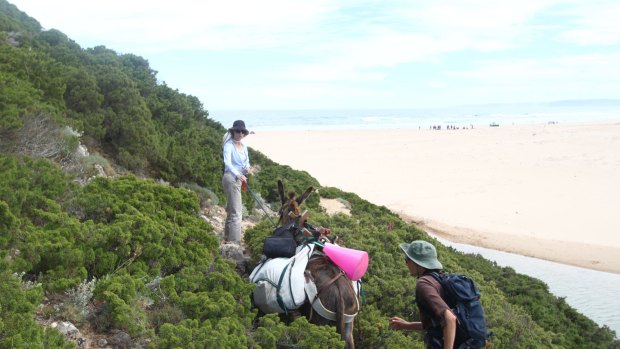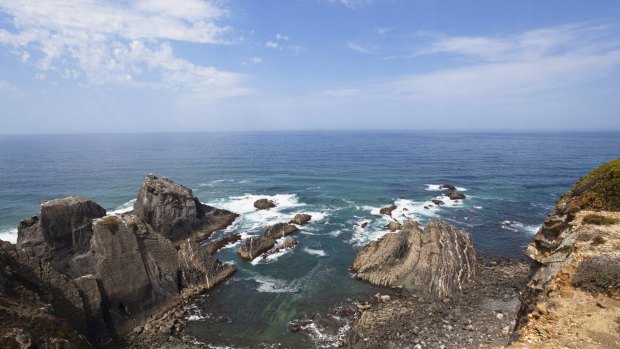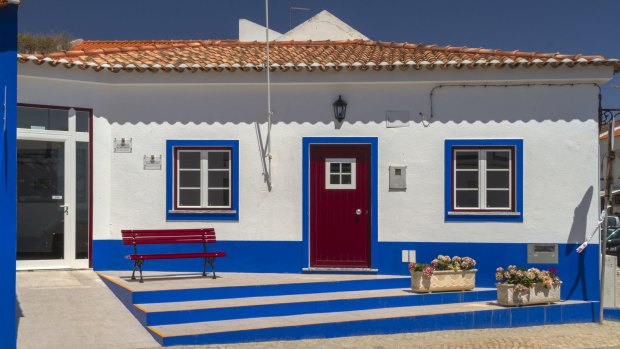This was published 9 years ago
Hiking Rota Vicentina in Portugal with a donkey
Hiking Portugal’s Rota Vicentina packs in more than a few surprises for Kate Armstrong.
By Kate Armstrong

Hiking with donkeys: Sofia with Chiquito, a seven-year-old donkey.Credit: Kian Barker
ADVENTURE
There's nothing like a disagreement between travelling companions to test your friendship. Especially when he happens to be a donkey. I've just hit the road with Chiquito, my four-legged walking buddy for the next three days. I stride out purposefully. Chiquito follows behind. Suddenly, he stops. I pull on his rope. He refuses to budge. We're not going anywhere in a hurry.
We are hiking sections of the Rota Vicentina (St Vincent's Route), a stunning 350-kilometre hiking route that runs the western coast of Portugal in a protected strip known as the Parque Natural do Sudoeste Alentejano e Costa Vicentina. The route starts at the tiny seaside village of Porto Covo and ends at Cabo de Sao Vicente (St Vincent's Cape), one of Europe's most southwestern points. Route – singular – is a slight misnomer; it comprises two paths – the "fishermen's trail" that hugs the actual coast for 100 kilometres, and the "historic trail", an undulating path slightly inland that links various villages for 230 kilometres. Both trails are divided into signposted sections; these vary between 15 and 25 kilometres. And, like a sweet shop of hiking trails, you can select how and where you will hike: sections of each trail; the entire trails from start to finish; or, as we do, a combination of the two (sometimes they intersect). There's no such thing as a bad choice here: numerous village and country accommodation options and excellent eateries dot the routes.

Costa Vicentina near Odeceixe, Algarve, Portugal.Credit: Getty Images
Unlike Spain's Santiago de Compostela trail, Rota Vicentina holds little religious significance to hikers today. It was a different story in the past, however, when pilgrims journeyed through the area to visit the body of Iberian Saint Vincent at Cape St Vincent (Lisbon's patron saint – his body was moved to the city in 1173). Nevertheless, the route is equally as captivating for other reasons, not least for the spectacularly rugged coastline which has changed very little since the fifteenth century when Henry the Navigator established his navigation school near the cape.
My own exploration of the area begins with an afternoon's donkey briefing, a compulsory part of any trek with the company "Burros & Artes" ("Donkeys & Art"), based in the small village of Aljezur and run by Sofia von Mentzingen, a gentle German-Portuguese woman. We like her immediately. She is mother to 12 donkeys, all of which have been rescued from mistreatment. "Donkeys are nervous for a reason – it's to do with the way of life they had before, their age, being hit on the ears. I can always tell what they've had done to them, such as when I use a brush to clean them, or have a broom in my hands, and they don't like it," she says.
Chiquito, our designated donkey, is only seven years old. He is curious and frisky, the result perhaps of having been tethered by rope to a stake for five years before Sofia took him in. He seems a little unsure of us and turns to face the other way when we approach. It's not a great start but Sofia assures us he'll warm up. I hope so.

A house in the colours of the coast at Porto Covo.Credit: Getty Images
Sofia meticulously drills us about Chiquito's equipment: halter, rope, brush, blanket. Plus the French saddle, an X-shaped, wooden contraption from which we hang our cotton saddle bags (30 kilograms' maximum of luggage). We learn when to tighten and loosen the back strap and how to tether, feed and water him near our accommodation in the evenings.
Even though Sofia will accompany us she advises: "Remember: the first job of the donkey is not as a luggage transport, but as a travel companion. Donkeys enjoy walking but we have to adapt ourselves to their rhythm. You must learn to go at Chiquito's pace."
Our route – from Praia de Monte Clerigo, near the pretty medieval village of Alejezur, to the tiny rural settlement of Vilarinha – will cover a distance of 55 kilometres. It will take us along the coast over the undulating hills forests and cork trees and continue slightly inland before hitting the coast again.
Our first day – from Praia de Monte Clerigo to Praia da Arrifana – covers only 12 kilometres. We head first to the beach, a stunning sweep of sand. Chiquito shies from the sea: donkeys, we discover, dislike water. From here we wind our way up a narrow path until we are atop golden-coloured cliffs. Chiquito, trailing behind, pricks up his ears. The Atlantic Ocean rages below, a drop of several hundred metres. My first surprise is the region's pretty coastal plants: camarinha (wolf) berries, wild garlic and bushman's fig.
By the second day – a longer 24-kilometre walk from Praia da Arrifana, slightly inland to Carrapateira – we are becoming more comfortable with our donkey, and he with us. Just as Sofia had advised, Chiquito's pace varies: slow (when going uphill) and fast (when going downhill). It's a rhythm broken only when we stop for unexpected delights such as an archaeological site: the ruins of a monastery dating to 1130, the time of the Moors who exploited the region's wood for shipbuilding and mulberries for silk production. It also affords us brief rests in the shade and swims in the chilly Atlantic waters whose swells attract hoards of surfers and surf schools, and short detours to watch the occasional eagle. (Unfortunately, it's June so there are few birds, unlike the European autumn when migratory species fly over the cape.)
The pace also allows a natural and unobtrusive entry into local life. At the small rocky cove of Praia do Canal we pass a small, ramshackle hut. Out shuffles Dom Joaquim, a former fishermen who, Sofia tells us, is 91 years old. He leans awkwardly on his walking stick and waves. His hand chops backwards through the air, reminiscent of the Pope's greeting. It's a beautiful welcome gesture. Dom Joaquim is used to foreigners; campervans occupy his "front yard". (Camping is illegal in this protected region, though sadly, with no jurisdiction to fine the culprits, authorities seem to turn a blind eye.)
More appealing are the area's varied plants. My favourites are the rock rose, a peculiar plant with leaves that are sticky and shiny, plus wild lavender, Umbelliferae, Helichrysum and chamomile.
Lunches, too, are a treat. Each day we spread out a picnic cloth under tree shade, respite from the strong sun and dine on bread, chorizo and goats' cheese. To reward Chiquito, Sofia removes his saddle so he can roll on the dusty road; donkeys do this as a way of cleaning and massaging themselves.
Fully sated, we plod on. At Carrapateira, whose beach is a surfing mecca, golden dunes spread and beyond, calcareous rocks reveal layers of shell and coral fossils. We explore the ruins of an Islamic fishermen's village, a reminder that people have been here for hundreds of years. Even today, fishermen perch with their rods on the perilous cliffs, hauling in massive fish which they eat themselves, or sell (informally) to local restaurants.
It is to these we head each evening, after tending to Chiquito, to feast on fresh local catches: grilled sea bream, red snapper and sole, always perfectly grilled and served simply, with boiled potatoes and a lemon wedge.
On our final evening at Monte do Sapeiro, a lovely converted farmhouse-cum-luxury accommodation, owners Pedro and Natercia prepare a meal of perceves (barnacles) that Pedro, a fisherman, has collected off the rocks.
After dinner, Pedro pulls out his home-brewed medronho, a feisty liquor. Its effect brings on nostalgia. I imagine I'm Robyn Davidson of Tracks fame who, unknowingly a proponent of Slow Hiking, walked alone for over 2000km with her camels across the Australian desert at her camels' pace.
Of course, I'm ill-prepared for such extreme adventures and not a great fan of large animals, unless viewing them from a safari vehicle. But I think, Chiquito and I have become friends; he has even started to nudge me with his head. We've both come a long way since the first morning when, on watching our initial standoff, Sofia, the donkey whisperer, gently reminds me that you can never pull a donkey. Instead, you must push gently from behind.
TRIP NOTES
MORE INFORMATION
GETTING THERE
Qantas flies to Lisbon via London. See qantas.com.au.
TOURING THERE
Rota Vicentina's official website has maps and detailed stage descriptions of the historic and fishermen's trails, along with accommodation listings. See rotavicentina.pt.
Burros & Artes in Vale das Amoreiras, Aljezur, rents out donkeys for guided and do-it-yourself hikes; costs vary according to the length of trips. You must arrange your accommodation in advance. See burros-artes.blogspot.com.au.
STAYING THERE
There are numerous places to stay that cater to all budgets, including youth hostels, B&Bs and guest houses. The most upmarket stays are in Casas Brancas (White Houses), see casasbrancas.com; Monte do Sapeiro, in Vilarinha, 8 kilometres from Carrapateira, has high-season doubles with breakfast for $143 a night. See montedosapeiro.com.
The writer was a guest of Monte do Sapeiro and Casas Brancas: Herdade do Telheiro and Casa Vicentina. She was also assisted by Muxima Guest House.
Sign up for the Traveller Deals newsletter
Get exclusive travel deals delivered straight to your inbox. Sign up now.